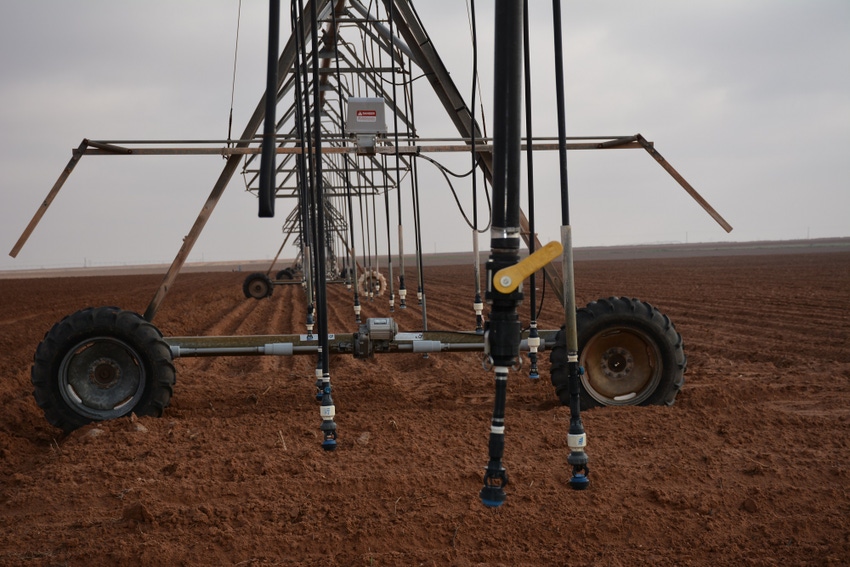
As water resources become more scarce, with increased competition by users, conservation efforts become more important. That’s especially true for agricultural producers, who must compete with municipalities and other types of industry for the necessary water to grow their crops.
Like it or not, crop irrigation represents one of the major users of water, and another reason producers must become more conservation-minded and diligent in their efforts to use less water to grow more crops. The less water farmers use for irrigation, the longer the precious resource will last.
In arid or semi-arid regions, dryland farming is either impossible or nearly impossible, both in terms of production yield and input costs versus net profits. It's no secret that if yields go down and input costs continue to rise, farmers see little point in putting seed in the ground.
DIVERSE AGRICUUTRE
The Texas Panhandle, a major agricultural region, includes wheat, corn, milo, peanuts, soybeans, sunflowers, hay crops, and cotton production. It also boasts a lot of beef producers, and regardless of how you look at it, sufficient water is a must across the region if agriculture is to survive.
In the early 20th century, Panhandle farmers started using groundwater extensively, which led to dramatic drops in groundwater levels; some places witnessed record 400 foot declines. The construction of dams, canals, and reservoirs beginning in the 1930s saw the return of as much as 300 feet to some groundwater supplies. But research shows increasing irrigation demand since the 1950s has offset these gains by more than 100 feet.
Officials at the Panhandle Groundwater Conservation District (PGCD) understand. The district provides conservation support to producers in Armstrong, Carson, Donley, Gray, Hutchinson, Potter, Roberts, and Wheeler counties in Texas, and has been watching groundwater supplies diminish for years, especially over the last two decades.
They are currently helping area producers implement irrigation conservation efforts, and have done so for a number of consecutive years by participating in the Texas Water Development Board’s (TWDB) low interest water conservation loan program.
This year, the TWDB has awarded the district a $1 million loan to continue regional efforts to reduce irrigation water use by utilizing conservation equipment and practices. The loans help farmers purchase costly irrigation equipment that promotes conservation efforts.
ALTERNATE IRRIGATION SYSTEMS
"This is not our first year to receive these loan funds, but each year we are able to provide more assistance to our farmers, who are making a great effort to reduce water use in their fields," says C.E. Williams, general manager for PGCD.
"When producers irrigate using furrows, it has been estimated that one ground well can irrigate up to about 100 acres, but with pivot irrigation that well can provide water for about 120 to 125 acres. So, for each cropland field that has changed to pivot irrigation, we are using less water."
The low interest loans available to producers offer a rate of about 1.5 percent, Williams says, so the TWDB program is a vital part of regional conservation efforts.
For the latest on southwest agriculture, please check out Southwest Farm Press Daily and receive the latest news right to your inbox.
Dr. Bridget Scanlon, senior research scientist at the University of Texas at Austin, says current rates of replenishment in the Panhandle are very low, and water is being pulled out of the Ogallala aquifer faster than it is being replenished.
"It’s just like a bank,” she says. “If you withdraw money faster than you deposit money, you will eventually run out. The groundwater depletion rate in the northern Texas panhandle is now at least 10 times its recharge rate," so water conservation is a 'must do' practice for producers.”
OTHER OPTIONS
While pivot irrigation is producing positive conservation results, it's not the only form of conservation irrigation the district is pushing.
"We have also provided loans for three different drip irrigation systems that have provided very promising results," Williams says. "It is a more costly system to implement, and there are some management considerations, such as cracks in the ground, or rodents that can cause damage to underground lines. But it is proving to be a more efficient irrigation system overall."
Asked if drip irrigation would be the preferred choice for water conservation efforts in the years ahead, Williams indicates he believes it is. It comes down to availability of investment capital for conservation irrigation equipment, he says, and thanks to low-interest loans like those managed by the Texas Water Development Board, producers in the Panhandle are making some progress.
About the Author(s)
You May Also Like




